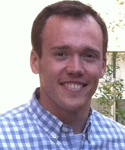
|
Andrew Wendorff
Department of Aeronautics & Astronautics
Durand Building, Room 464
Stanford, CA 94305
Background
Ph.D. Candidate, Aeronautics & Astronautics, Stanford University, 2013-present.
M.S., Aeronautics & Astronautics, Stanford University, 2013.
B.S., Aerospace Engineering, University of Kansas, 2011.
Research Interests
- Computational Fluid Dynamics (CFD)
- Multidisciplinary Design, Analysis, & Optimization (MDAO)
- Multi-Information Source Optimization
- Conceptual and Preliminary Aerospace Vehicle Design
- Air-Breathing Orbital Insertion Vehicles
- Uncertainty Quantification
- Optimization under Uncertainty
- Multi-Fidelity Analysis
- Certification through Simulation
- SU2
- SUAVE - see publications below
Work is currently being conducted at combining multiple information sources into a single architecture to better understand how different sources with different uncertainties can be balanced with their respective costs to create aerodynamic databases for less cost.

NASA CRM constructed in AVL.

Pressure coefficient obtained from SU2 for NASA CRM.

Potential aerodynamic coefficents at different angles of attack for NASA CRM.
The major application at present in this research is looking at stability and control considerations of aircraft during the conceptual design phase. We are trying to manage the uncertainty inherent in different analysis codes to better estimate control surface sizes and allow additional aircraft capabilities to be incorporated into the initial design. As part of this analysis, we are looking into simulation different flight trajectories with stochastic aerodynamic databases to get a probability an aircraft can successfully meet certification requirements.

Deterministic instances of aerodynamic database incorporating wind tunnel and SU2 data.

Varying flight profiles of deterministic databases created from stochastic database.
Beyond determining how to integrate multiple data sources into one database, we are looking into different algorithms to determine where in the design space the uncertainty in the underlying database affects the maneuver of interest uncertainty. We are currently using multiple Gaussian Processes to determine this “best” next sampling point.

Generalized representation of algorithm to determine where to place next sample.

Representative function used to determine where to add a high fidelity sample to reduce variance on time to descend of emergency descent maneuver for NASA CRM.
Publications
|
Wendorff, A., Alonso, J. J., and Bieniawski, S., "Using Multiple Information Sources to Construct Stochastic Databases to Quantify Uncertainty in Certification Maneuvers," AIAA 2016-1420, 57th AIAA/ASCE/AHS/ASC Structures, Structural Dynamics, and Materials Conference, San Diego, CA, January 2016.
|
|
Botero, E., Wendorff, A., Lukaczyk, T., Alonso, J. J., Orra, T., and Ilario, C., et. al., “SUAVE: An Open-Source Environment for Conceptual Vehicle Design and Optimization,” AIAA 2016-1275, 54th AIAA Aerospace Sciences Meeting, San Diego, CA, January 2016.
|
|
Wendorff, A., Alonso, J. J., and Bieniawski, S., "A Multi-Fidelity Approach to Quantification of Uncertainty in Stability and Control Databases for use in Stochastic Aircraft Simulations," AIAA 2015-3439, 16th AIAA Multidisciplinary Analysis and Optimization Conference, Dallas, TX, June 2015.
|
|
Lukaczyk, T., Wendorff, A., Colonno, M., Economon, T., Alonso, J.J., Orra, T., Ilario, C., et.al., "SUAVE: An Open-Source Environment for Multi-Fidelity Conceptual Vehicle Design," AIAA 2015-3087, 16th AIAA Multidisciplinary Analysis and Optimization Conference, Dallas, TX, June 2015.
|
|

